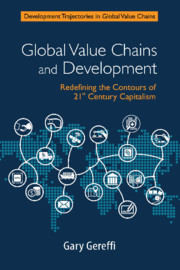Book contents
- Frontmatter
- Dedication
- Contents
- List of Tables
- List of Figures and Boxes
- Foreword
- Acknowledgments
- Sources
- 1 The Emergence of Global Value Chains: Ideas, Institutions, and Research Communities
- Part I Foundations of the Global Value Chain Framework
- 2 The Organization of Buyer-Driven Global Commodity Chains: How US Retailers Shape Overseas Production Networks
- 3 International Trade and Industrial Upgrading in the Apparel Commodity Chain
- 4 The Governance of Global Value Chains
- Part II Expanding the Governance and Upgrading Dimensions in Global Value Chains
- Part III Policy Issues and Challenges
- Co-authors
- Index
2 - The Organization of Buyer-Driven Global Commodity Chains: How US Retailers Shape Overseas Production Networks
from Part I - Foundations of the Global Value Chain Framework
Published online by Cambridge University Press: 09 November 2018
- Frontmatter
- Dedication
- Contents
- List of Tables
- List of Figures and Boxes
- Foreword
- Acknowledgments
- Sources
- 1 The Emergence of Global Value Chains: Ideas, Institutions, and Research Communities
- Part I Foundations of the Global Value Chain Framework
- 2 The Organization of Buyer-Driven Global Commodity Chains: How US Retailers Shape Overseas Production Networks
- 3 International Trade and Industrial Upgrading in the Apparel Commodity Chain
- 4 The Governance of Global Value Chains
- Part II Expanding the Governance and Upgrading Dimensions in Global Value Chains
- Part III Policy Issues and Challenges
- Co-authors
- Index
Summary
Global industrialization is the result of an integrated system of production and trade. Open international trade has encouraged nations to specialize in different branches of manufacturing and even in different stages of production within a specific industry. This process, fueled by the explosion of new products and new technologies since World War II, has led to the emergence of a global manufacturing system in which production capacity is dispersed to an unprecedented number of developing as well as industrialized countries (Harris, 1987; Gereffi, 1989b). The revolution in transportation and communications technology has permitted manufacturers and retailers alike to establish international production and trade networks that cover vast geographical distances. While considerable attention has been given to the involvement of industrial capital in international contracting, the key role played by commercial capital (i.e., large retailers and brand-named companies that buy but don't make the goods they sell) in the expansion of manufactured exports from developing countries has been relatively ignored.
This chapter will show how these ‘big buyers’ have shaped the production networks established in the world's most dynamic exporting countries, especially the newly industrialized countries (NICs) of East Asia. The argument proceeds in several stages. First, a distinction is made between producer-driven and buyer-driven commodity chains, which represent alternative modes of organizing international industries. These commodity chains, though primarily controlled by private economic agents, are also influenced by state policies in both the producing (exporting) and consuming (importing) countries.
Second, the main organizational features of buyer-driven commodity chains are identified, using the apparel industry as a case study. The apparel commodity chain contains two very different segments. The companies that make and sell standardized clothing have production patterns and sourcing strategies that contrast with firms in the fashion segment of the industry, which has been the most actively committed to global sourcing. Recent changes within the retail sector of the United States are analyzed in this chapter to identify the emergence of new types of big buyers and to show why they have distinct strategies of global sourcing.
Third, the locational patterns of global sourcing in apparel are charted, with an emphasis on the production frontiers favored by different kinds of US buyers. Several of the primary mechanisms used by big buyers to source products from overseas are outlined in order to demonstrate how transnational production systems are sustained and altered by American retailers and branded apparel companies.
- Type
- Chapter
- Information
- Global Value Chains and DevelopmentRedefining the Contours of 21st Century Capitalism, pp. 43 - 71Publisher: Cambridge University PressPrint publication year: 2018
- 5
- Cited by



